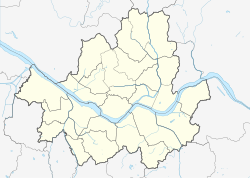Cheongnyangni 588
Cheongnyangni 588 | |
|---|---|
 Cheongnyangni 588 in 2013 | |
| Coordinates: 37°34′41″N 127°02′41″E / 37.57806°N 127.04472°E | |
| District | Dongdaemun District |
| City | Seoul |
| Area | |
• Total | 4 ha (10 acres) |
Cheongnyangni 588 was a red-light district in Seoul, South Korea near Cheongnyangni station.[1] At its peak in the 1980s it housed 200 brothels and 500 prostitutes, and was the largest red-light district in Seoul.[2][3] Cheongnyangni is often referred to as "Oh Pal Pal", meaning "five eight eight" in Korean possibly due to a bus which once passed through the area.[2]
History
The area was first became used for prostitution during the 1910-1945 Japanese occupation following the building of Cheongnyangni Station.[2] In the 1950s during the Korean War, the station had many soldiers passing through it and these soldiers were the main customers for the area.[2]
The lifting of the nighttime curfew in 1982, (which had been in place since the end of WW2),[4] increased trade to the area.[2]
In 1988 Seoul hosted the Summer Olympics.[5] In an attempt to improve the area ahead of the Olympics, windows were fitted to the front of the sex establishments in the style of Amsterdam's De Wallen district. This improvement of the area was backed by the government.[2]
In 2004, the South Korean government passed an anti-prostitution law (Special Law on Sex Trade 2004) prohibiting the buying and selling of sex and shutting down brothels.[6] Although now illegal, and despite police crackdowns, the area continued.[2]
Closure
The Seoul Metropolitan Government (SMG) set up a "Civic watchdog programme" to try to shut down the district in 2013, some vigilante actions occurred under this scheme.[7]
Plans to redevelop the area were announced by the SMG. The re-development entailed demolishing the area and building of four 65-story luxury residential-commercial complexes and a 42-story shopping mall by 2020.[8] At the end of 2016 the closure of the 156 brothels started, although may of the sex-workers had already left,[1] many having previously left to work in massage parlors or huegaetael (sex-hotels).[9] Demolition started in March 2017, at which time 8 brothels and 40 sex-workers were still operating.[8] One brothel remained in operation until March 2018.[7]
In literature
The Cheongnyangni district is mentioned in several works of fiction and non-fiction as the setting for a crime drama Seoul: Lost in the big city (ISBN 978-0956476517) and also in the book In Search of Life (ISBN 978-0956476500).
References
- ^ a b Ghosh, Subhro Prakash (20 March 2018). "Sex Trade At Cheongnyangni 588 Is A History, Commercial Complexes And Malls To Be Developed". koreaportal. Retrieved 27 December 2018.
- ^ a b c d e f g Se-jeong, Kim (23 February 2017). "Curtain falling on Seoul's red-light district called 588". koreatimes. Retrieved 27 December 2018.
- ^ "韓国ソウル最大の色街オーパルパルの昔と今" (in Japanese). KoreaWorldTimes. 2019-07-30. Retrieved 2020-05-19.
- ^ Shin, Paul (6 January 1982). "South Korea reports peaceful end to 36-year curfew". UPI. Retrieved 27 December 2018.
- ^ "Seoul 1988". olympic.org. Archived from the original on 4 October 2009. Retrieved 27 December 2018.
- ^ "South Korea gets tough on sex tourism". The Sydney Morning Herald. September 20, 2007.
- ^ a b Borowiec, Steven; Ghani, Faras (19 March 2018). "South Korea: Sex workers hit hard by government's crackdown". www.aljazeera.com. Al Jazeera. Retrieved 27 December 2018.
- ^ a b Da-sol, Kim (15 March 2017). "Korea's infamous red-light zone to fade into history". www.koreaherald.com. The Korea Herald. Retrieved 27 December 2018.
- ^ Kang, Yewon (28 November 2014). "South Korea's Sex Industry Thrives Underground a Decade After Crackdown". The Wall Street Journal. Retrieved 27 December 2018.

